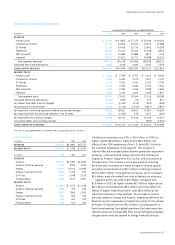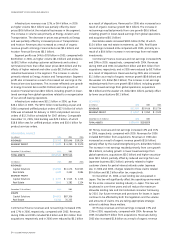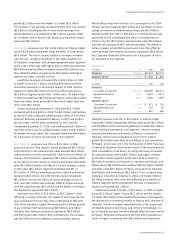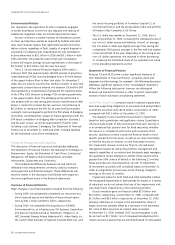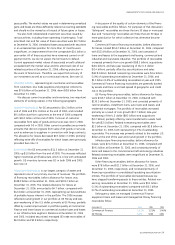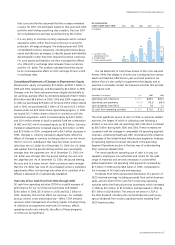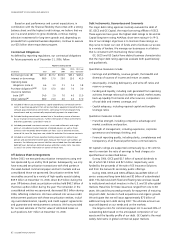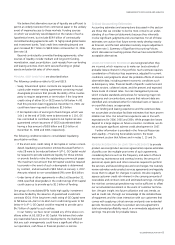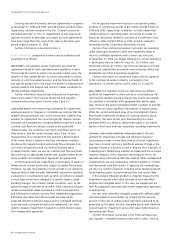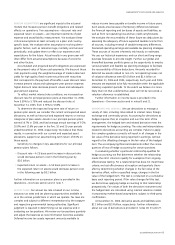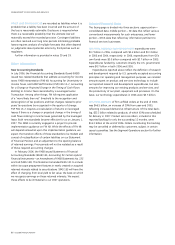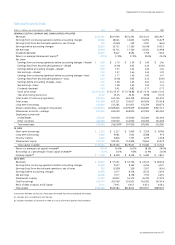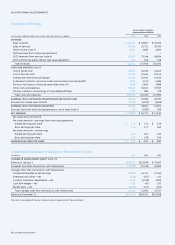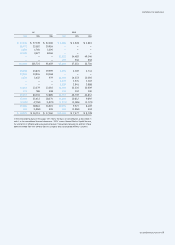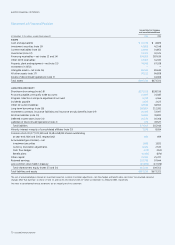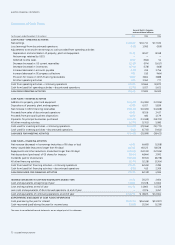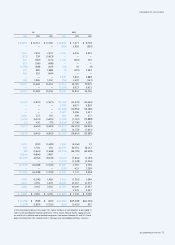GE 2006 Annual Report Download - page 65
Download and view the complete annual report
Please find page 65 of the 2006 GE annual report below. You can navigate through the pages in the report by either clicking on the pages listed below, or by using the keyword search tool below to find specific information within the annual report.’
We believe that alternative sources of liquidity are suffi cient to
permit an orderly transition from commercial paper in the unlikely
event of impaired access to those markets. Funding sources
on which we would rely would depend on the nature of such a
hypothetical event, but include $59.9 billion of contractually
committed lending agreements with 75 highly-rated global banks
and investment banks. Total credit lines extending beyond one
year increased $2.7 billion to $59.8 billion at December 31, 2006.
See note 18.
Beyond contractually committed lending agreements, other
sources of liquidity include medium and long-term funding,
monetization, asset securitization, cash receipts from our lending
and leasing activities, short-term secured funding on global
assets and potential sales of other assets.
PRINCIPAL DEBT CONDITIONS are described below.
The following conditions relate to GE and GECS:
• Swap, forward and option contracts are required to be exe-
cuted under master-netting agreements containing mutual
downgrade provisions that provide the ability of the counter-
party to require assignment or termination if the long-term
credit rating of either GE or GECS were to fall below A–/A3.
Had this provision been triggered at December 31, 2006, we
could have been required to disburse $2.9 billion.
• If GE Capital’s ratio of earnings to fixed charges, which was
1.64:1 at the end of 2006, were to deteriorate to 1.10:1, GE
has committed to contribute capital to GE Capital. GE also
guaranteed certain issuances of GECS subordinated debt
having a face amount of $0.8 billion and $1.0 billion at
December 31, 2006 and 2005, respectively.
The following conditions relate to consolidated, liquidating
securitization entities:
• If the short-term credit rating of GE Capital or certain consoli-
dated, liquidating securitization entities discussed further in
note 28 were to be reduced below A–1/P–1, GE Capital would
be required to provide substitute liquidity for those entities
or provide funds to retire the outstanding commercial paper.
The maximum net amount that GE Capital would be required
to provide in the event of such a downgrade is determined
by contract, and amounted to $8.0 billion at January 1, 2007.
Amounts related to non-consolidated SPEs were $0.6 billion.
• Under terms of other agreements in effect at December 31,
2006, specified downgrades in the credit ratings of GE Capital
could cause us to provide up to $1.1 billion of funding.
One group of consolidated SPEs holds high quality investment
securities funded by the issuance of guaranteed investment
contracts (GICs). If the long-term credit rating of GE Capital were
to fall below AA–/Aa3 or its short-term credit rating were to fall
below A–1+/P–1, GE Capital could be required to provide up to
$4.7 billion of capital to such entities.
In our history, we have never violated any of the above con-
ditions either at GE, GECS or GE Capital. We believe that under
any reasonable future economic developments, the likelihood
that any such arrangements could have a significant effect on
our operations, cash flows or financial position is remote.
Critical Accounting Estimates
Accounting estimates and assumptions discussed in this section
are those that we consider to be the most critical to an under-
standing of our financial statements because they inherently
involve significant judgments and uncertainties. For all of these
estimates, we caution that future events rarely develop exactly
as forecast, and the best estimates routinely require adjustment.
Also see note 1, Summary of Significant Accounting Policies,
which discusses accounting policies that we have selected from
acceptable alternatives.
LOSSES ON FINANCING RECEIVABLES are recognized when they
are incurred, which requires us to make our best estimate of
probable losses inherent in the portfolio. Such estimate requires
consideration of historical loss experience, adjusted for current
conditions, and judgments about the probable effects of relevant
observable data, including present economic conditions such
as delinquency rates, financial health of specific customers and
market sectors, collateral values, and the present and expected
future levels of interest rates. Our risk management process,
which includes standards and policies for reviewing major risk
exposures and concentrations, ensures that relevant data are
identified and considered either for individual loans or leases, or
on a portfolio basis, as appropriate.
Our lending and leasing experience and the extensive data
we accumulate and analyze facilitate estimates that have proven
reliable over time. Our actual loss experience was in line with
expectations for 2006, 2005 and 2004. While prospective losses
depend to a large degree on future economic conditions, we do
not anticipate significant adverse credit development in 2007.
Further information is provided in the Financial Resources
and Liquidity — Financing Receivables section, the Asset
Impairment section that follows and in notes 1, 13 and 14.
REVENUE RECOGNITION ON LONG-TERM AGREEMENTS to provide
product services (product services agreements) requires estimates
of profits over the multiple-year terms of such agreements,
considering factors such as the frequency and extent of future
monitoring, maintenance and overhaul events; the amount of
personnel, spare parts and other resources required to perform
the services; and future billing rate and cost changes. We routinely
review estimates under product services agreements and regularly
revise them to adjust for changes in outlook. We also regularly
assess customer credit risk inherent in the carrying amounts of
receivables and contract costs and estimated earnings, including
the risk that contractual penalties may not be sufficient to offset
our accumulated investment in the event of customer termina-
tion. We gain insight into future utilization and cost trends, as
well as credit risk, through our knowledge of the installed base
of equipment and the close interaction with our customers that
comes with supplying critical services and parts over extended
periods. Revisions that affect a product services agreement’s
total estimated profitability result in an immediate adjustment of
earnings. We provide for probable losses.
ge 2006 annual report 63


